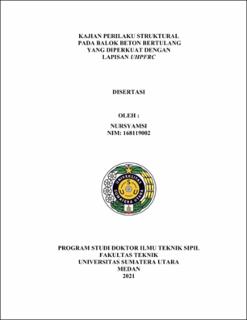| dc.contributor.advisor | Tarigan, Johannes | |
| dc.contributor.advisor | Bakar, Badorul Hisham Abu | |
| dc.contributor.advisor | Hardjasaputra, Harianto | |
| dc.contributor.author | Nursyamsi, Nursyamsi | |
| dc.date.accessioned | 2024-08-19T04:08:04Z | |
| dc.date.available | 2024-08-19T04:08:04Z | |
| dc.date.issued | 2021 | |
| dc.identifier.uri | https://repositori.usu.ac.id/handle/123456789/95620 | |
| dc.description.abstract | The use of concrete as a building material is very common nowadays. Damage to
reinforced concrete structures is unavoidable. Therefore, the strengthening of
reinforced concrete structures whose quality has decreased is a major problem. The
damage that occurred was due to the earthquake that occurred. Indonesia is located
in an earthquake-prone area, which makes structural reinforcement technology very
important in the Indonesian construction world. The development of new
reinforcement methods and designs and environmentally friendly materials is very
important to extending the life of reinforced concrete structures. UHPFRC is one
type of construction material that continues to grow. However, this material has not
been used in the construction of structures because it still requires a new design
concept and effective application. The use of UHPFRC and wire mesh is a new
approach and its performance is still not promising. In this study, fifteen specimens
of reinforced concrete beams reinforced with UHPFRC layers were prepared. One
reinforced concrete beam was determined as the control beam, and the other
reinforced concrete beam was tested with a load of 50% of the ultimate load
capacity of the control beam. Then, reinforced concrete beams that are already in
damaged condition are reinforced using variations of the Strip-Shape and U-Shape.
One reinforced concrete beam from each variation of reinforcement is coated with
UHPC with wire mesh. The deflection results of reinforced concrete beam testing
were validated by numerical calculation modelling using the Ansys program. The
test results show that the control beam and all the reinforced concrete beams fail in
the flexural mode. Reinforced concrete beams with Strip-Shape variations provide
an increase in the maximum load capacity of 14.45 % to 43.48 %, while for the UShape
variation it is 46.09 % to 149.37 %. Reinforced concrete beams reinforced
with UHPFRC layers, both Strip-Shape and U-Shape variations, and wire mesh
variations resulted in ductility factors greater than 4 and 3. These values indicate
that both UHPFRC and UHPC layers with wire mesh are feasible as materials.
reinforcement of reinforced concrete beams located in the seismic area. Judging
from the overall results obtained, the reinforcement carried out reached the
optimum value on the Strip-Shape layer with a thickness of 20 mm and on the UShape
layer with a thickness of 10 mm. The deflection values generated in
laboratory testing are also well described in the Ansys program with a difference of
1.44 % on the control beam; 1.19 % on SS- and 0.33 % on US-1. | en_US |
| dc.language.iso | id | en_US |
| dc.publisher | Universitas Sumatera Utara | en_US |
| dc.subject | reinforced concrete beam | en_US |
| dc.subject | UHPFRC | en_US |
| dc.subject | reinforcement | en_US |
| dc.subject | flexural failure | en_US |
| dc.subject | ductility factor | en_US |
| dc.subject | SDGs | en_US |
| dc.title | Kajian Perilaku Struktural pada Balok Beton Bertulang yang Diperkuat dengan Lapisan UHPFRC | en_US |
| dc.title.alternative | Structural Behavior Study of Reinforced Concrete Beams Reinforced with UHPFRC Layers | en_US |
| dc.type | Thesis | en_US |
| dc.identifier.nim | NIM168119002 | |
| dc.identifier.nidn | NIDN0024125605 | |
| dc.identifier.kodeprodi | KODEPRODI22001#Ilmu Teknik Sipil | |
| dc.description.pages | 240 Pages | en_US |
| dc.description.type | Disertasi Doktor | en_US |


